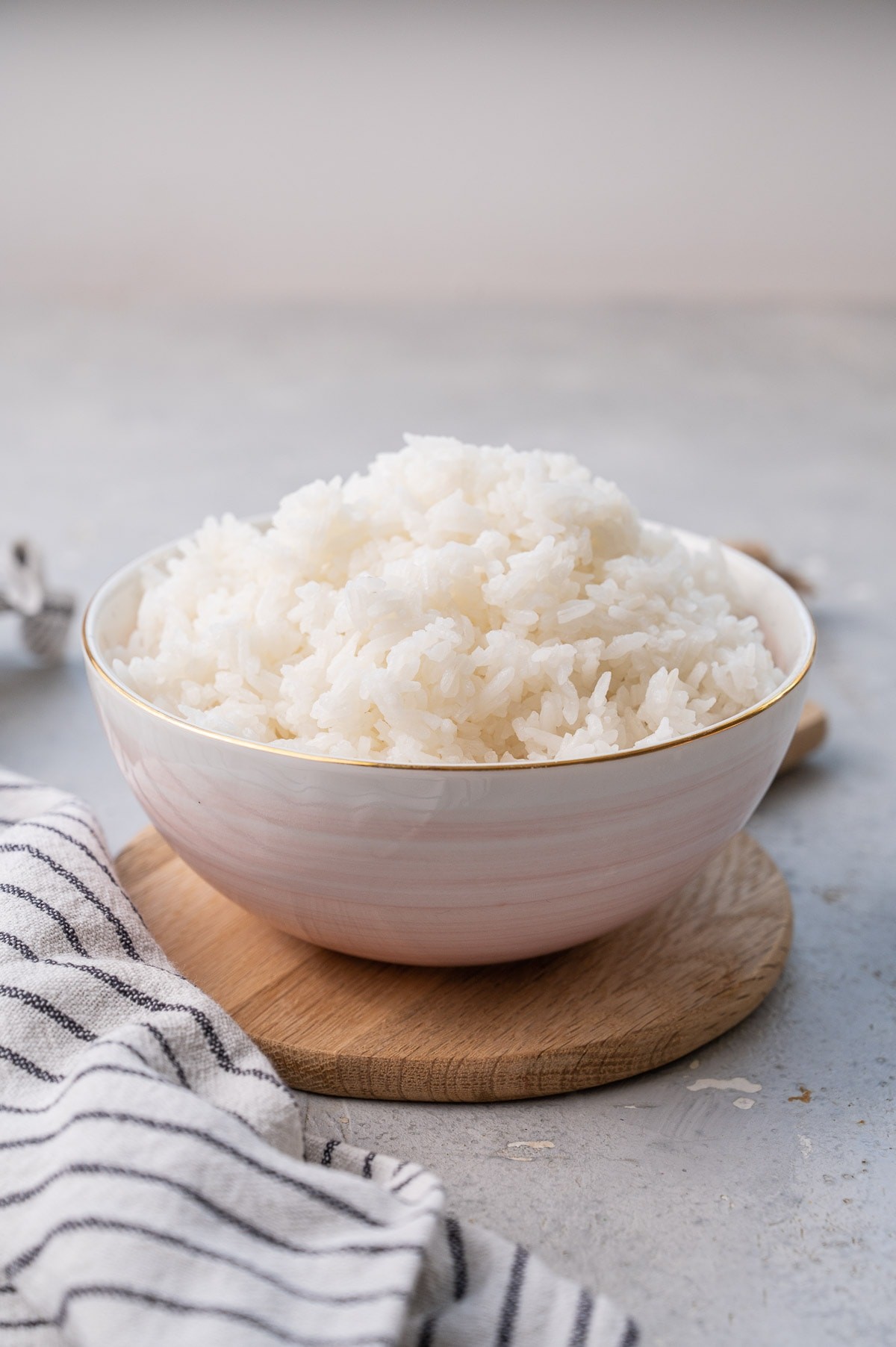
Contents
Jasmine Rice for Weight Loss and Health: Facts and Benefits
Jasmine rice boasts a sweet aroma reminiscent of the jasmine flower. With fewer calories than regular rice, it becomes an excellent choice for weight loss.
Rice, a versatile and popular food, plays a vital role in cuisines worldwide. While consumed most in Asia, Sub-Saharan Africa, and South America, Americans also enjoy it in various dishes. Jasmine rice, an increasingly popular grain, promotes itself as a healthier substitute for regular rice. But can it truly help with weight loss and is it healthy? Let’s explore.
Jasmine rice offers numerous health benefits, making it an excellent alternative to other kinds of rice. However, like all starches, it carries certain risks, especially if you watch your weight closely.
Discover the distinctions between jasmine rice and its regular counterpart, along with essential nutritional facts about these grains.
Originating in Thailand, jasmine rice derives its name from its unique aroma, reminiscent of the jasmine flower. Thailand remains a leading producer of this fragrant rice, accounting for 80-85% of its exports to the United States during the 2019-2020 growing season.
There are three categories of rice: long-grain, medium-grain, and short-grain. Jasmine rice is classified as a long-grain variety, characterized by a dry, fluffy texture and individual grains that don’t clump when cooked.
What is Regular Rice?
Regular rice, often referred to as white rice due to its pale color, is a processed grain. Manufacturers refine rough rice through a multi-step process to create white rice and other related products. While this refining process extends shelf life, it also strips away several natural nutrients by removing the bran layer. Although manufacturers enrich white rice with minerals and vitamins, it remains less healthy than many other rice varieties.
Using Jasmine Rice and Regular Rice
Both jasmine rice and regular rice are versatile ingredients that can enhance the flavor of many dishes. Whether you pair them with meats like chicken and pork or incorporate them into vegetarian meals, there are countless options for enjoying rice. While jasmine rice tends to be pricier than white rice, both kinds are generally affordable.
Some popular rice dishes include burritos, casseroles, chicken alla pitocca, corn rice, curry, fried rice, paella, rice pudding, risotto, tacos with rice, and wild rice arugula salad. Additionally, you can feed plain white rice to dogs with gastrointestinal issues as it is easy to digest and can soothe upset stomachs.
Nutritional Comparison of Jasmine Rice and Regular Rice
Jasmine rice and regular white rice differ in their nutritional contents. This table offers a quick comparison:
| Nutrients | 1 cup of jasmine rice | 1 cup of enriched, long-grain white rice |
| Calories | 181 kcal | 205 kcal |
| Protein | 4 g | 4.25 g |
| Total Lipd (fat) | 0.644 g | 0.442 g |
| Carbohydrates | 39 g | 44.6 g |
| Fiber, total dietary | 0.98 g | 0.632 g |
| Calcium | 19.6 mg | 15.8 mg |
| Iron | 0.364 mg | 1.9 mg |
QUESTION
Is Jasmine Rice Healthier Than Regular Rice?
As shown in the table above, jasmine rice contains fewer calories compared to regular rice, making it a healthier choice for weight loss. Jasmine rice also has slightly fewer carbohydrates, which can be advantageous since a high-carbohydrate diet may lead to health issues like high blood pressure, coronary heart disease, and Type 2 diabetes.
By opting for jasmine rice, you’ll benefit from increased fiber intake. Foods rich in fiber offer numerous advantages, such as prolonged satiety after meals, improved digestion, and enhanced gut health.
In addition, jasmine rice contains a higher amount of calcium, an essential mineral for bone and teeth health. Calcium also plays a crucial role in blood clotting and nerve signal transmission.
However, white rice does offer specific nutritional benefits over jasmine rice. Manufacturers often enrich white rice with vital minerals and vitamins during the refining process. For instance, a 1-cup serving of white rice contains 67.9 mg of phosphorus, which is essential for DNA, RNA, bone, and teeth health. White rice also provides 55.3 mg of potassium, an electrolyte that supports digestion, muscle contraction, and other bodily functions.
While jasmine rice is generally more nutritious than regular rice, both varieties offer valuable nutrients.
Can Jasmine Rice Aid in Weight Loss?
Jasmine rice can contribute to weight loss in certain situations. Research indicates that regular consumption of whole grains is associated with maintaining a healthy body weight.
Much of jasmine rice’s weight loss benefits can be attributed to its fiber content. Studies demonstrate that increasing dietary fiber intake is an effective method for reducing weight and appetite.
However, it’s important to note that jasmine rice has a higher glycemic index compared to some other varieties like brown rice. High-glycemic foods can lead to uncontrolled spikes in blood sugar levels, potentially resulting in diabetes, weight gain, and other adverse effects.
In conclusion, jasmine rice is a relatively healthy option with fewer calories, increased calcium and fiber content compared to regular rice. Nevertheless, it’s recommended to consume this delicious grain in moderation to avoid health issues like obesity and Type 2 diabetes.
Sources:
– American Kennel Club: "Can Dogs Eat Rice?"
– Colorado State University Kendall Reagan Nutrition Center: "Is Rice Good For You?"
– FoodData Central: "Jasmine Rice," "Rice, white, long-grain, regular, enriched, cooked."
– Harvard T. H. Chan School of Public Health: "Carbohydrates and Blood Sugar," “Rice."
– IFT Food Facts: "How Brown Rice Becomes White Rice."
– International Journal of Food Science: "Evaluation of the Obesity Prevention, Blood Glucose, and Blood Lipid Control of Vietnamese Rice Varieties in High-Fat Diet-Induced Obese Mice."
– The Journal of Nutrition: "Fiber Intake Predicts Weight Loss and Dietary Adherence in Adults Consuming Calorie-Restricted Diets: The POUNDS Lost (Preventing Overweight Using Novel Dietary Strategies) Study."
– Journal of Nutritional Science and Vitaminology: "Volatile Aroma Compounds in Jasmine Rice as Affected by Degrees of Milling."
– National Institutes of Health: "Phosphorus."
– North Dakota State University: "Got Calcium?"
– Nutrition Journal: "Whole grain consumption trends and associations with body weight measures in the United States: results from the cross sectional National Health and Nutrition Examination Survey 2001–2012."
– PBS: "Rice Recipes."
– University of California Irvine Susan Samueli Integrative Health Institute: "Why Fiber is Important to Your Health."
– USDA Economic Research Service: "Rice Sector at a Glance," "Sharp increase in imports from Asia boosted U.S. 2019/20 rice imports to record high, with little decline projected for 2020/21."


